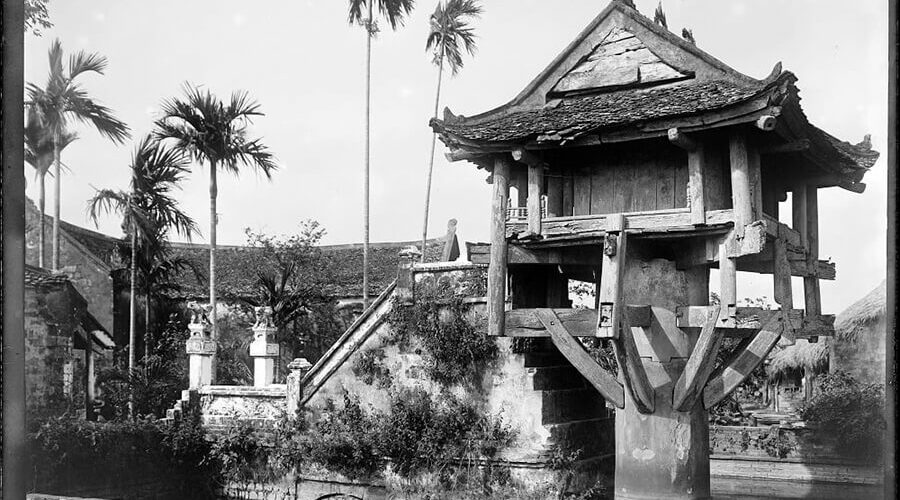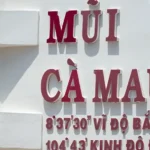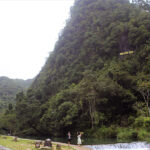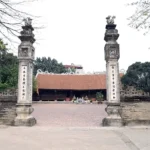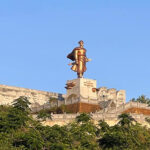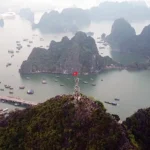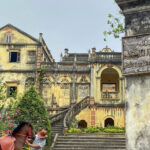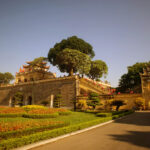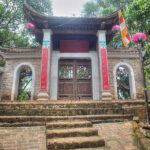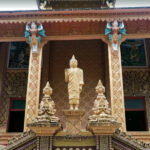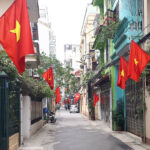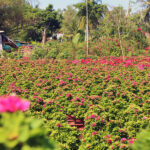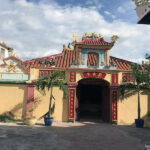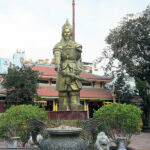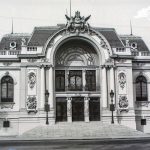In Hanoi, there is a tourist destination that you should not miss when coming to visit the capital: One Pillar Pagoda. The pagoda not only has the most unique architecture in Asia but is also a spiritual destination and cultural symbol of Hanoi, a thousand-year-old capital. Let’s learn about One Pillar Pagoda in the following article!
History & legend of One Pillar Pagoda in Ha Noi
One Pillar Pagoda (Vietnamese: chùa Một Cột) is known by many different names such as Dien Huu Tu, Lien Hoa Dai or Mat Pagoda. This is one of the ancient pagodas in Hanoi built during the reign of Emperor Ly Thai Tong.
Legend has it that the story of the One Pillar Pagoda was associated with the dream of the Emperor. In 1049, Ly Thai Tong dreamed that Guanyin Buddha gave him a shining lotus flower. When he woke up, he told the mysterious dream to his soldiers. After that, monk Thien Tue advised the Emperor to build a pagoda to remember the great gratitude and kindness of the Guanyin.

As in a dream, the pagoda erected an ironwood pillar, making the lotus seat of Guanyin Buddha placed on the pillar. That was how the One Pillar Pagoda built! At first, it was named Dien Huu Pagoda, which literally means “long-lasting happiness and good luck”.
During the reign of Emperor Ly Nhan Tong, the pagoda was renovated to add a lake and decorated with a gilded lotus flower at the top of the column. Inside the One Pillar Pagoda is a temple with a sculpture of a divine bird on the roof and a gold-plated altar to worship the statue of Guanyin.

One Pillar Pagoda has undergone many restorations and repairs in the Tran, Le and Nguyen Dynasties. In 1954, the French army set explosives to destroy the pagoda before withdrawing from the capital. In 1955, the Vietnamese Government rebuilt the pagoda according to the design of architect Nguyen Ba Lang with the scale of a small pagoda. Since then, the pagoda has been preserved intact by Hanoi city.
Unique architecture of One Pillar Pagoda
The pagoda was recognized as a National Historical Architectural and Artistic Monument in 1962 and set a record as “The pagoda with the most unique architecture in Asia”. When coming to One Pillar Pagoda, the first thing that visitors can easily see is the triple-gate with a horizontal panel engraved with the three words “Dien Huu” Pagoda.

The gate of pagoda
The original structure of the One Pillar Pagoda was supported by wooden panels firmly attached to the stone pillars includes the Lien Hoa pedestal, roof and pillars. One Pillar Pagoda has an architectural style with only a small wooden pagoda located on a large stone pillar, placed in the middle of a lake – named Linh Chieu. It looks as beautiful as a giant lotus flower in the middle of the lake.

In particular, a pillar is a circular block built of two overlapping stone pillars. One part is submerged under the lake and the other part floats on the water surface up to 4m high. The column has a diameter of 1.2m wide and extremely sturdy.
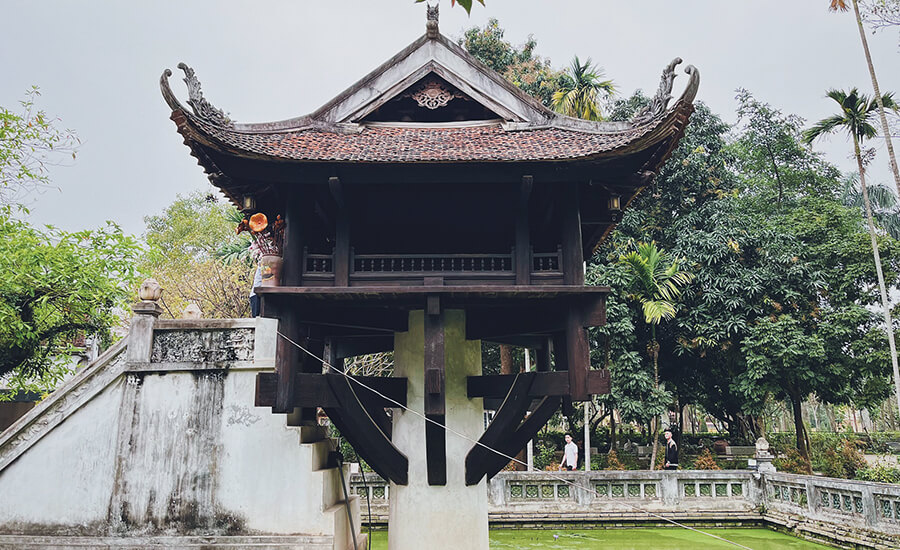
Lotus flower tower (Lien Hoa pedestal) is a square block, surrounded by huge bars, supported by a solid column system, underneath are large wooden beams that are directly mounted on stone pillars. The inside is splendidly decorated with a gilded statue of Guan Yin with a thousand eyes and a thousand hands.

The altar is decorated with many rattan motifs and painted with gold lacquer. Above is a small horizontal panel on a red painted background engraved with three golden words “Lien Hoa” pedestal.
The pagoda’s roof is covered with brick-red tiles that have grown moss over time, creating an ancient look of the pagoda. Each tile expressed the meticulous workmanship of the craftsman.

When making the roof, it would be the most difficult to assemble the tile at the corner of the gutter so that there are no gaps, as this is the position adjacent to the four sides of the roof.
On the top of the pagoda’s roof is the image of “two dragons flanking the moon” – a typical architectural feature of communal houses, pagodas, and shrines.

This architectural feature is a symbol of fertility, yin and yang harmony. This is the characteristic images imbued with humanity in the spiritual artistic architecture of the Vietnamese people.

In front of the small gate to the One Pillar Pagoda is a pair of stone mythical animal – guarding the pagoda, followed by a brick staircase with 13 steps leading up to the pagoda.
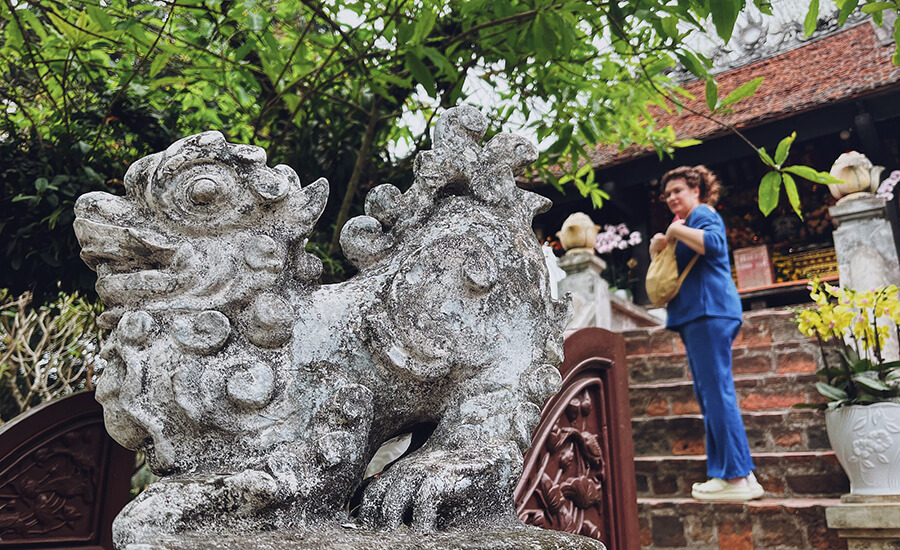
In addition to admiring the unique architecture, in the garden, there is currently a lush Bodhi tree from Buddha’s land, given by Indian President Rajendra Prasad on the occasion of President Ho Chi Minh’s visit to India in 1958.

Symbol of Hanoi’s thousand years of civilization
The pagoda is designed to resemble a lotus blossom, which is a Buddhist symbol of purity, since a lotus blossoms in a muddy pond. This familiar symbol of Hanoi appears in a lot of newspapers, books as well as educational programs. It has also appeared on the Vietnamese current – the coin 5,000 Đồng in the past.

- Location: on the campus next to the Ho Chi Minh Museum, next to Ba Dinh Square and Ho Chi Minh Mausoleum.
- Opening hours: daily from 8 am to 17 pm.
- Entrance fee: 25.000VND/1 ticket/1 foreigner.
Source: collected by An
Follow us for the best deal with Vietnam package tours and visa services!

















